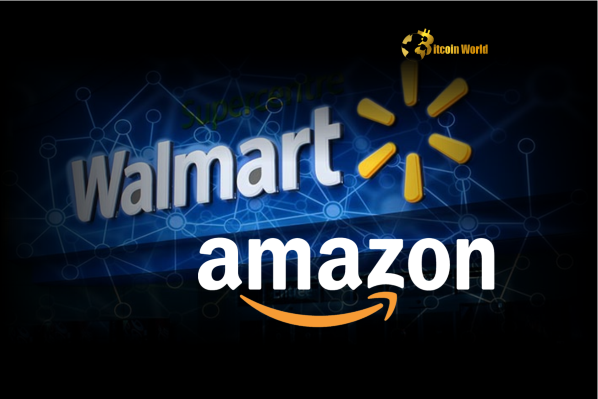BitcoinWorld

Retail Giant Stablecoin Exploration: Walmart and Amazon Eye Game-Changing Crypto Future
Imagine paying for your weekly groceries at Walmart or your latest online order from Amazon using a digital currency issued by the company itself. This futuristic scenario just got a little closer to reality, according to recent reports circulating in the financial world.
Initial whispers, amplified by Walter Bloomberg on X citing the Wall Street Journal, suggest that two of the world’s largest retail and e-commerce powerhouses, Walmart and Amazon, are reportedly exploring the launch of their own stablecoins. While details remain scarce and the reports are based on exploration rather than confirmed plans, the mere possibility sparks significant discussion about the future of payments, retail loyalty, and the broader adoption of digital currencies.
What Exactly is a Stablecoin, and Why Would Retail Giants Care?
Before diving into the specifics of a potential Walmart stablecoin or Amazon stablecoin, let’s clarify what a stablecoin is. Unlike volatile cryptocurrencies like Bitcoin or Ethereum, stablecoins are designed to maintain a stable value, typically pegged to a traditional asset like the US dollar, a commodity, or even an algorithm. This stability makes them suitable for everyday transactions, unlike volatile crypto assets which are often treated more like investments.
So, why would colossal entities like Walmart and Amazon be interested? The motivations are multi-faceted and potentially revolutionary for their business models:
- Reducing Transaction Costs: Traditional payment systems (credit cards, banks) involve fees that cut into profit margins. A proprietary stablecoin could significantly lower these costs, especially for high-volume transactions.
- Faster Settlements: Transactions can settle almost instantly on a blockchain, compared to the days it can take for traditional payments to clear. This improves cash flow efficiency.
- Enhanced Loyalty Programs: A stablecoin could be integrated directly into loyalty programs, offering instant rewards, discounts, or even interest-bearing accounts for held balances.
- Accessing the Unbanked/Underbanked: In many parts of the world, and even within developed nations, a significant population remains outside the traditional banking system. A company-issued stablecoin could provide a digital payment method accessible via a simple smartphone app.
- Creating a Closed-Loop Ecosystem: A stablecoin could facilitate seamless transactions within their vast networks of suppliers, customers, and partners, creating a powerful internal economy.
- Gathering Valuable Data: Transaction data within their stablecoin ecosystem could provide unparalleled insights into consumer behavior and supply chain dynamics.
Exploring the Potential: A Walmart Stablecoin?
Walmart, with its massive physical footprint and extensive supply chain, presents a compelling case for exploring a Walmart stablecoin. Imagine a digital currency that streamlines payments from distribution centers to suppliers, or allows customers to pay instantly at checkout, potentially earning tokenized rewards.
For Walmart, a stablecoin could:
- Simplify and reduce costs in its complex global supply chain.
- Offer a faster, potentially cheaper payment option for its millions of daily customers.
- Integrate loyalty points directly with a spendable digital asset.
- Potentially offer financial services (like lending or savings) built around the stablecoin for its customers and employees.
Previous reports have indicated Walmart’s interest in crypto and blockchain technologies, including exploring ways to allow customers to pay with crypto. A stablecoin would be a natural, albeit significant, evolution of this interest, offering more control and tailored functionality than simply accepting existing cryptocurrencies.
Exploring the Potential: An Amazon Stablecoin?
Amazon, the undisputed king of e-commerce, also has powerful incentives to explore an Amazon stablecoin. Its global reach, integration with AWS (Amazon Web Services), and diverse business lines (e-commerce, cloud computing, logistics, entertainment) offer numerous potential use cases.
An Amazon stablecoin could:
- Revolutionize online payments globally, potentially bypassing traditional card networks and their associated fees.
- Facilitate micropayments for digital content or services on AWS.
- Be used for international remittances or cross-border payments within Amazon’s ecosystem.
- Offer a universal payment method across its various platforms (Amazon.com, Prime Video, Audible, etc.).
Given Amazon’s scale, a successful stablecoin launch could rapidly become one of the most widely used digital currencies globally, instantly bringing E-commerce crypto payments to the mainstream for millions of users.
What Does a Retail Giant Stablecoin Mean for the Market?
The entry of a Retail giant stablecoin from players like Walmart or Amazon would send significant ripples through the financial and cryptocurrency markets. It would represent a major validation of blockchain technology and digital currencies from mainstream corporate America.
Potential impacts include:
- Increased Crypto Awareness: Millions of consumers who have never interacted with crypto might suddenly find themselves using a blockchain-based asset.
- Competition for Existing Payment Systems: Visa, Mastercard, and traditional banks could face significant pressure on fees and services.
- Competition for Existing Stablecoins: Tether (USDT) and USD Coin (USDC) could face a formidable new competitor with immense user bases and distribution channels.
- Regulatory Scrutiny: Such large-scale corporate stablecoins would undoubtedly attract intense regulatory attention globally.
- Innovation in Retail Payments: Other retailers might be compelled to explore similar solutions or partner with existing crypto providers to keep up.
This move highlights the growing trend of Corporate stablecoin initiatives, as companies seek to leverage blockchain for efficiency and control over their financial operations and customer interactions.
Challenges and Hurdles Ahead
While the potential benefits are vast, launching a stablecoin is no simple feat, even for giants like Walmart and Amazon. Significant challenges lie ahead:
1. Regulatory Approval: This is arguably the biggest hurdle. Stablecoins are under increasing scrutiny worldwide regarding consumer protection, financial stability, and anti-money laundering (AML) regulations. Obtaining necessary licenses and complying with varying global rules would be complex and time-consuming.
2. Adoption and Trust: While they have massive customer bases, convincing users to adopt and trust a new digital currency, especially one issued by a corporation, requires significant effort and education. Data privacy concerns could also be a factor.
3. Technical Implementation: Building and maintaining a secure, scalable, and reliable blockchain infrastructure capable of handling millions of transactions per day is a massive technical undertaking.
4. Integration: Seamlessly integrating the stablecoin into their existing complex payment systems, online platforms, and physical stores requires extensive development.
5. Competition: They would face competition not only from traditional payment methods but also from established stablecoins and potentially other tech giants or financial institutions launching their own digital currencies.
Looking Ahead: What Should We Watch For?
The reports about Walmart and Amazon’s exploration are just the beginning of a potentially transformative journey. Here’s what to keep an eye on:
- Official Confirmations: The most important step will be any official announcement from either company regarding their stablecoin plans.
- Regulatory Developments: Pay close attention to how regulators in the US and other key markets approach stablecoins. Their stance will heavily influence the viability of these projects.
- Partnerships: Will they build everything in-house, or partner with existing blockchain technology providers or financial institutions?
- Use Cases: What specific problems are they trying to solve? The initial use cases outlined will reveal their strategic goals.
- Pilot Programs: Any small-scale tests or pilot programs could provide early insights into their approach and challenges.
The move, if it materializes, signifies a potential shift in how major corporations view and utilize digital assets, pushing E-commerce crypto and retail payments into a new era.
Conclusion: A Potential Game-Changer on the Horizon
The rumors surrounding Walmart and Amazon’s exploration of stablecoin launches are more than just fleeting headlines; they represent a significant indicator of how major corporations are evaluating the potential of digital currencies to reshape their core businesses. While regulatory hurdles and technical complexities remain substantial, the potential benefits in terms of cost savings, efficiency, customer loyalty, and control over their ecosystems are clearly attractive.
Whether a Walmart stablecoin or an Amazon stablecoin ultimately sees the light of day remains to be seen. However, the fact that these retail giants are seriously exploring the concept underscores the growing inevitability of digital assets playing a larger role in mainstream commerce. This exploration by two of the world’s largest companies is a powerful testament to the potential of blockchain technology and stablecoins to revolutionize payments and commerce, potentially ushering in a new era of Retail giant stablecoin adoption and driving further innovation in the Corporate stablecoin space and the broader world of E-commerce crypto.
To learn more about the latest explore our article on key developments shaping stablecoin institutional adoption.
This post Retail Giant Stablecoin Exploration: Walmart and Amazon Eye Game-Changing Crypto Future first appeared on BitcoinWorld and is written by Editorial Team





